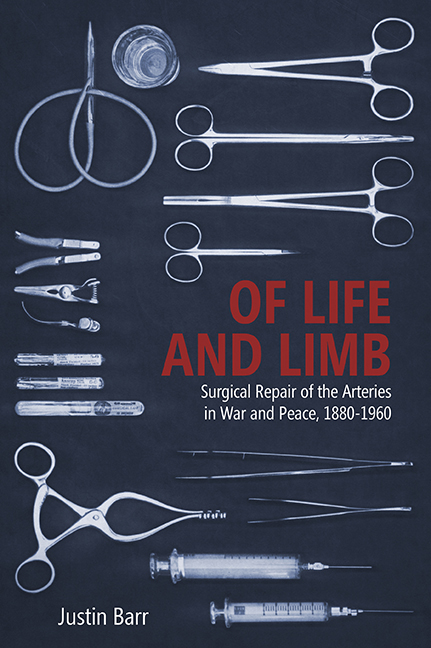 Surgical Repair of the Arteries in War and Peace, 1880–1960
Surgical Repair of the Arteries in War and Peace, 1880–1960 Book contents
- Frontmatter
- Contents
- Acknowledgments
- Introduction
- 1 Technical Change, Practical Stasis: The Development of Arterial Repair through 1914
- 2 An Ideal Rarely Practiced: Arterial Repair and Its Alternatives from World War I to World War II
- 3 Opportunities Realized and Discarded: The Management of Vascular Trauma in World War II
- 4 Reshaping Surgical Infrastructure between World War II and the Korean War
- 5 An Ideal Implemented: Arterial Repair in the Korean War
- 6 Bringing It All Back Home
- Conclusion: Arterial Repair and the Process of Surgical Change
- Notes
- Bibliography
- Index
6 - Bringing It All Back Home
Published online by Cambridge University Press: 29 March 2020
- Frontmatter
- Contents
- Acknowledgments
- Introduction
- 1 Technical Change, Practical Stasis: The Development of Arterial Repair through 1914
- 2 An Ideal Rarely Practiced: Arterial Repair and Its Alternatives from World War I to World War II
- 3 Opportunities Realized and Discarded: The Management of Vascular Trauma in World War II
- 4 Reshaping Surgical Infrastructure between World War II and the Korean War
- 5 An Ideal Implemented: Arterial Repair in the Korean War
- 6 Bringing It All Back Home
- Conclusion: Arterial Repair and the Process of Surgical Change
- Notes
- Bibliography
- Index
Summary
The emergence and propagation of arterial repair in the Korean War proved both its superiority over ligation for vascular trauma and, as important, the ability of average, residency-trained surgeons to perform the operation with success. If the procedure worked on severely injured patients in the austere, resource-limited environs of Korea, then its application in the comparatively stable, well-equipped operating rooms of the United States seemed the logical next step. This chapter demonstrates the rapid increase in the practice of arterial repair in the United States from the early 1950s until 1960, by which time it had been established as a common, standardized procedure in hospitals around the country. Presentations and publications from the Korean War experience provided data proving its potential. Individual drafted surgeons learned the techniques overseas and brought them home to stateside hospitals. There, they taught a new generation of residents the intricacies of this operation while demonstrating its superiority for patients.
Over the course of the 1950s, the indication for arterial repair expanded from trauma (both military and domestic) to atherosclerotic arterial disease. Long identified in the medical literature, atherosclerosis gained prominence in the 1950s as part of the general epidemiological shift from infectious to chronic diseases. Cholesterol-clogged arteries, supplying logarithmically more patients then trauma ever would, partly emerged as a prominent medical problem because of the curative potential of arterial repair. It simultaneously helped to develop the specialty of vascular surgery, which took increasing responsibility for the millions of Americans suffering from this condition.
The Rise of Arterial Repair in the United States
Between the end of the Korean War and 1960, arterial repair went from being a rare operation practiced almost exclusively at elite, academic hospitals by a few experts to a common one that every American surgeon was expected to perform. A review of the published literature reveals an explosion of people discussing the procedure. Google Ngrams, which track the appearance of words in written material, shows that usage of the phrase “vascular surgery” leaped fourfold between 1951 and 1960. The term “arterial repair” similarly surged more than twentyfold over those same years (figure 6.1). While writing about this method does not provide direct evidence of its performance, it does show an increasing level of interest.
- Type
- Chapter
- Information
- Surgical Repair of the Arteries in War and Peace, 1880–1960Surgical Repair of the Arteries in War and Peace, 1880–1960, pp. 137 - 155Publisher: Boydell & BrewerPrint publication year: 2019
